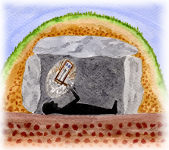
 |
The microclimate in a Neolithic passage tomb |
Poul Klenz Larsen, Lars Aasbjerg Jensen, Morten Ryhl-Svendsen, Tim Padfield
Microclimate measurements in a Neolithic passage grave in Denmark have shown that natural ventilation through the open entrance destabilizes the relative humidity (RH), whereas a sealed entrance gives a much more stable RH, above 90%. Episodes of condensation occur on the stone surfaces in summer with too much ventilation and in winter with too little ventilation. Soil moisture measurements above, below and beside the grave mound indicate that rainfall on the mound is not a significant source of moisture to the chamber whereas the ground below the sealed chamber is constantly moist. The chamber can be kept dry all year by putting a moisture barrier membrane over the floor. Apart from the more variable climate within the open chamber there is also a significant penetration of ozone, which is absent in the sealed chamber. The ozone may have deteriorated the folds of birch bark put between the horizontal sandstone slabs within the chamber. The damage is supposed to have happened when the chamber was left open during the last 200 years. Visitors touching the fragile bark may be another cause of damage. Keeping the entrance closed seems to be the best solution for preserving the remaining birch bark.
Maglehøj is a Neolithic passage grave with a well preserved chamber within a grass covered earth mound.

External view of Maglehøj from the south east. The entrance is at the right side of the mound. The outside weather station is in front of the mound.
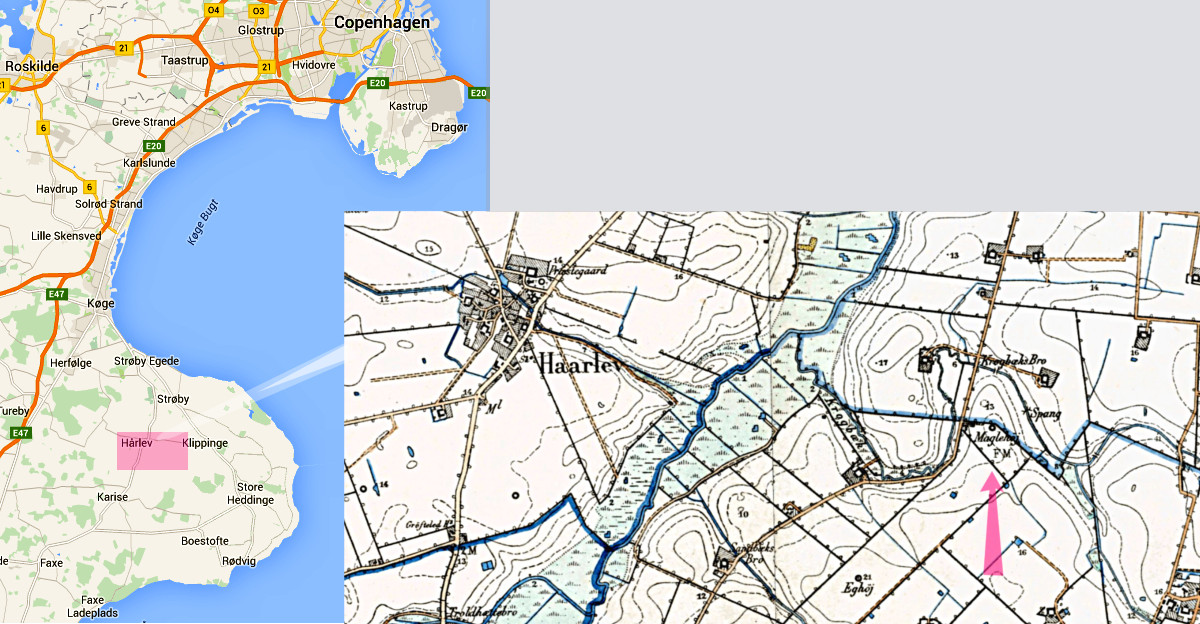
The site is south of Copenhagen in an area of farmland.
The chamber walls consist of large stones with infill of small horizontal sandstone slabs.
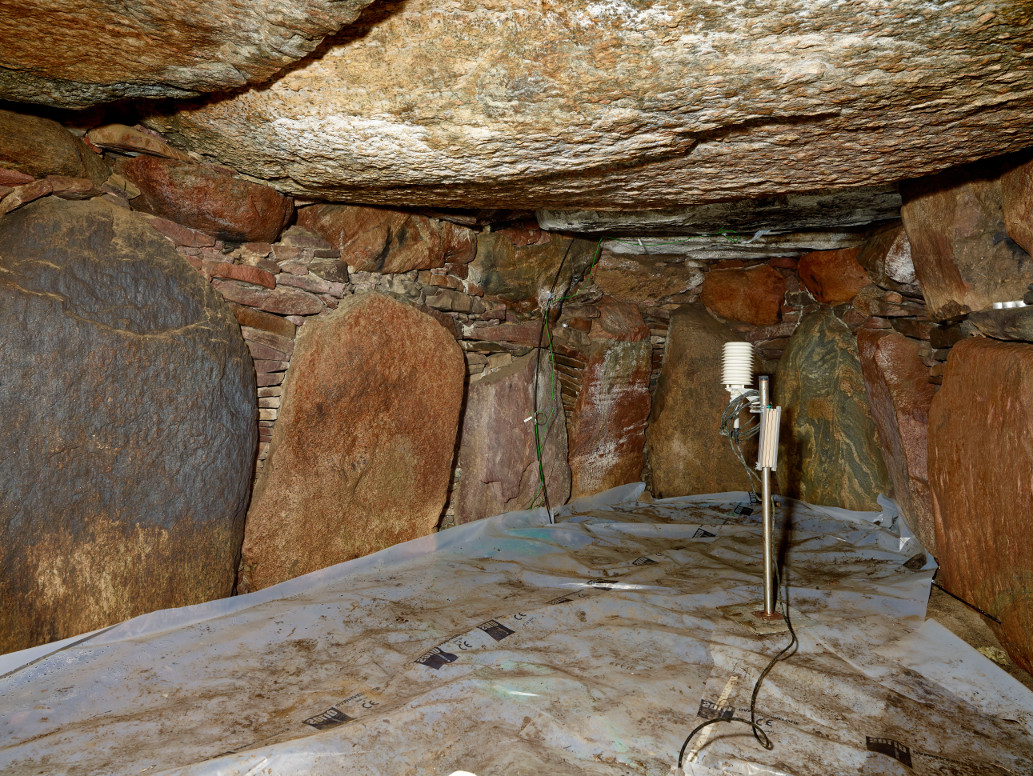
Internal view of the chamber from the south east corner. The inside weather station is located in the center, on top of the floor membrane, which was installed in 2015. (photo by Roberto Fortuna)
The horizontal joints were sealed with folds of birch bark, an unusual detail that has enabled a precise carbon-14 dating of the site to 5200 BP.
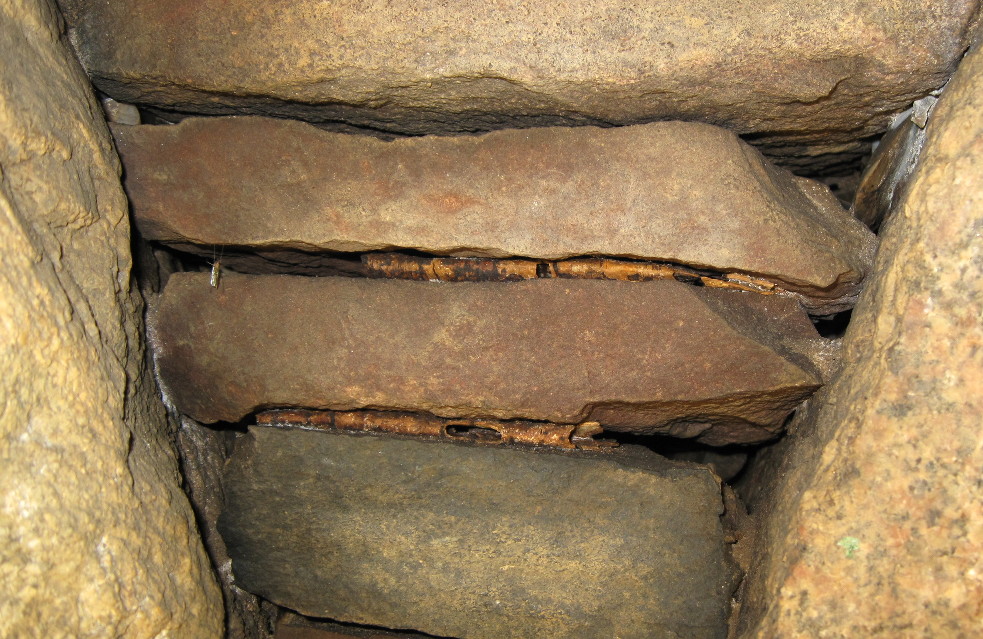
A detail of the dry wall sections between the large wall stones. The layers of folded birch bark are visible between the sandstone slabs.
When the chamber was reopened in 1823, the bark was described as well preserved, in written accounts. Only few remains of burials were found, and the bones were reburied outside the mound. The chamber remained open and freely accessible. Today, the bark is brittle and fragile, crumbling in many places or already lost in some areas. The chamber was closed for public access with a steel lattice door a few years ago, to prevent visitors from destroying the remaining pieces of bark by touching or tampering with it.
There are only a few other sites of the same age with remnants of bark used similarly, but it may have been a common practice for sealing or decorating chambers, of which there are around 500 left in Denmark (Dehn & Hansen, 2006). How did this organic material survive 5000 years in Maglehøj, yet apparently decompose so quickly after opening the chamber in modern times? Would it be better if the chamber was sealed again or should the door remain open? These questions have been studied for four years, focusing on the microclimate in the chamber and within the mound.
The chamber has an oval ground plan sized 5.6 x 2.7 m. The ceiling height is approximately 1.7 m. The entrance passage leads to the centre of the chamber. A frame of flat stones indicates that the entrance was closed by a door. The floor is level with the ground outside. There is no sign of flooring other than the soil. [In another passage grave of similar age, Birkehøj, a carefully designed original floor with a clay membrane and gravel fill stopped capillary moisture (Dehn et al, 1998)]. The roof of the chamber in Maglehøj consists of four large stones supported by twenty vertical stones in the walls. The thickness of the roof stones is not known, but the soil cover is 1.2 m where the soil moisture sensors were installed. The top side of the roof stones is covered by a layer of clay to protect against water penetration. The outside of the walls has an infill of gravel and crushed flint. This protects against rodents and drains away any penetrating rain water.
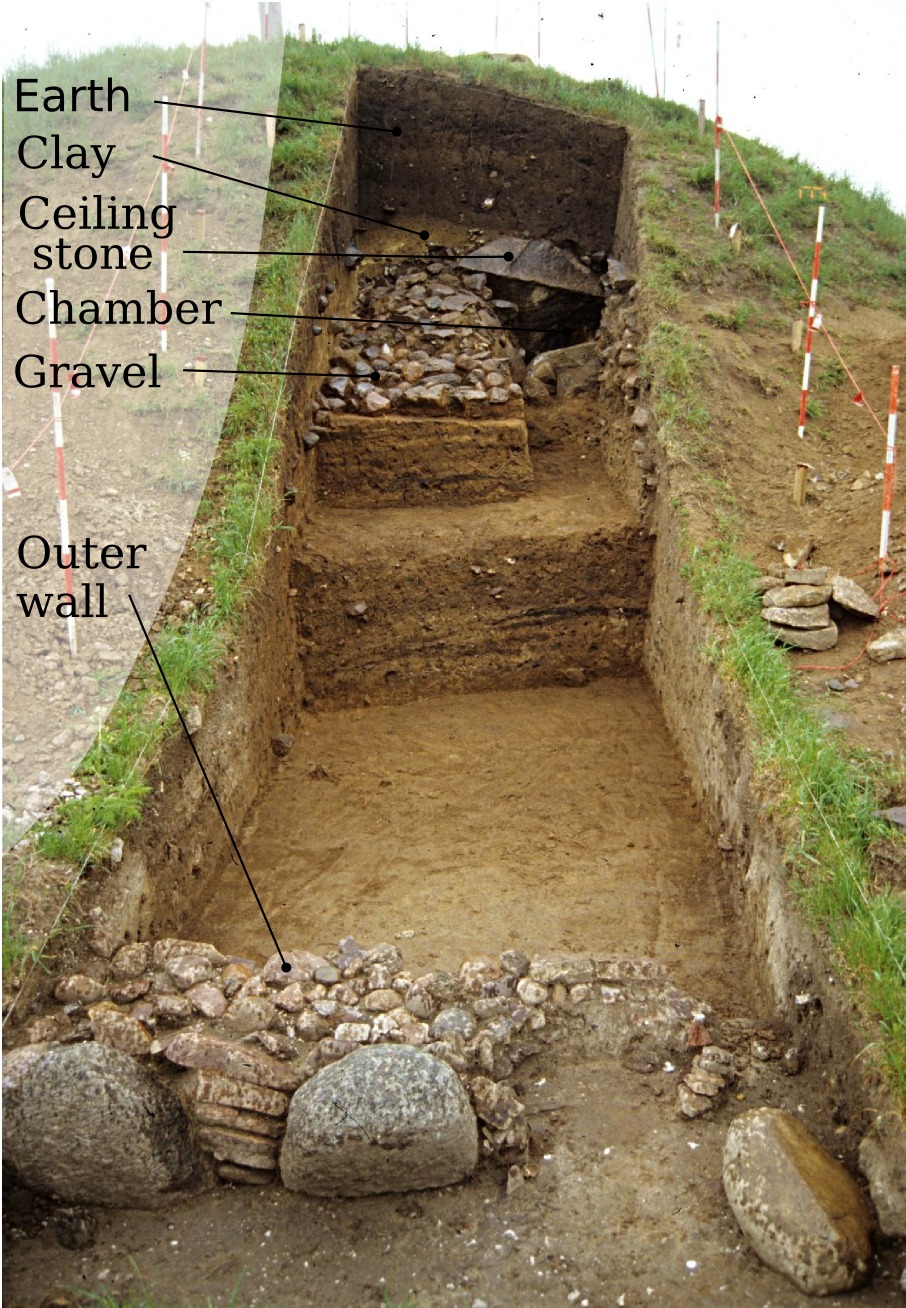
The structure of the mound, with protection of the chamber by an impermeable clay cap and gravel to drain the sides. Photo: Torben Dehn/Jørgen Westphal.
Birch bark was used throughout prehistory for many purposes and is found in numerous archaeological sites. Orsini et al (2015) reported on the degradation of birch bark from a vessel found in water logged conditions, and a bow case preserved in ice. SEM investigations showed more degradation of the microstructure of waterlogged birch bark than in birch bark preserved in ice. GC/MS analysis revealed that the bark had undergone depolymerization and oxidation reactions in both environments, but the waterlogged birch bark had more pronounced decay. From this it seems that both water and oxygen will break down the molecular structure of bark. Chemical degradation makes the bark stiff and brittle, susceptible to mechanical damage. In a study by Suryawanshi (2004) fresh bark lost 70 % of its tensile strength during accelerated aging at 105° C in 72 hours.
In the first year of measurements, free ventilation of the interior was allowed through the entrance. This continued the situation since the reopening of the chamber 200 years ago. In the second year, the entrance was sealed with an insulated solid door. This would resemble the situation for several millennia when the chamber went out of use. In the third year, a vapour barrier was installed over the floor to prevent diffusive vapour movement upwards into the chamber. The purpose of this intervention was to identify the source of humidity in the chamber. In the fourth year, measurements of ventilation rate and ozone concentration were performed.
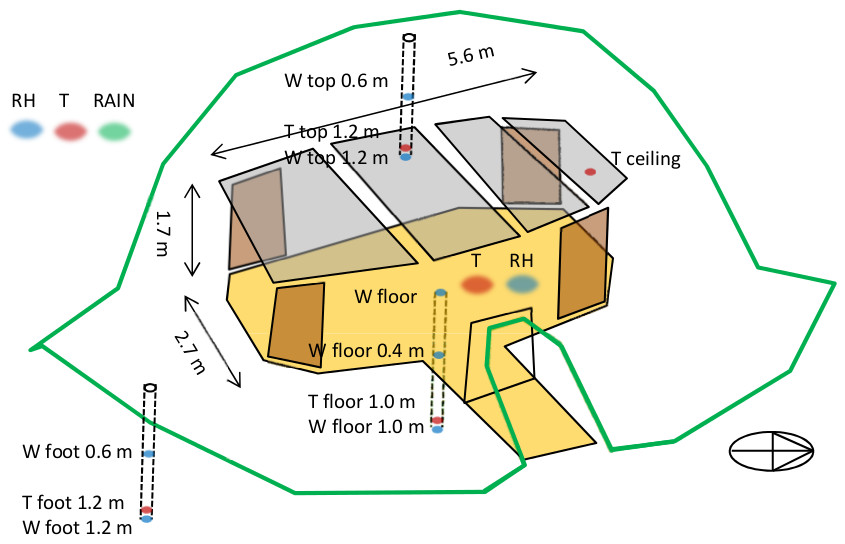
A sketch of the chamber within the mound showing the positions of the sensors used in this article. T = temperature, RH = relative humidity, W = soil moisture by gypsum block.
The inside and outside temperature (T) and relative humidity (RH) were monitored continuously for four years. The surface temperature was monitored in several positions on both vertical and horizontal surfaces. Soil wetness (W) was monitored with gypsum blocks mounted in the ground below the floor, in the mound above the chamber and beside the mound. The electrical resistance of the gypsum matrix was recalculated to suction pressure, which is a measure of soil moisture. The outside precipitation was recorded. The location of the sensors used in this article is shown in the figure above. A description of the instrumentation and all the sensors is given at the end.
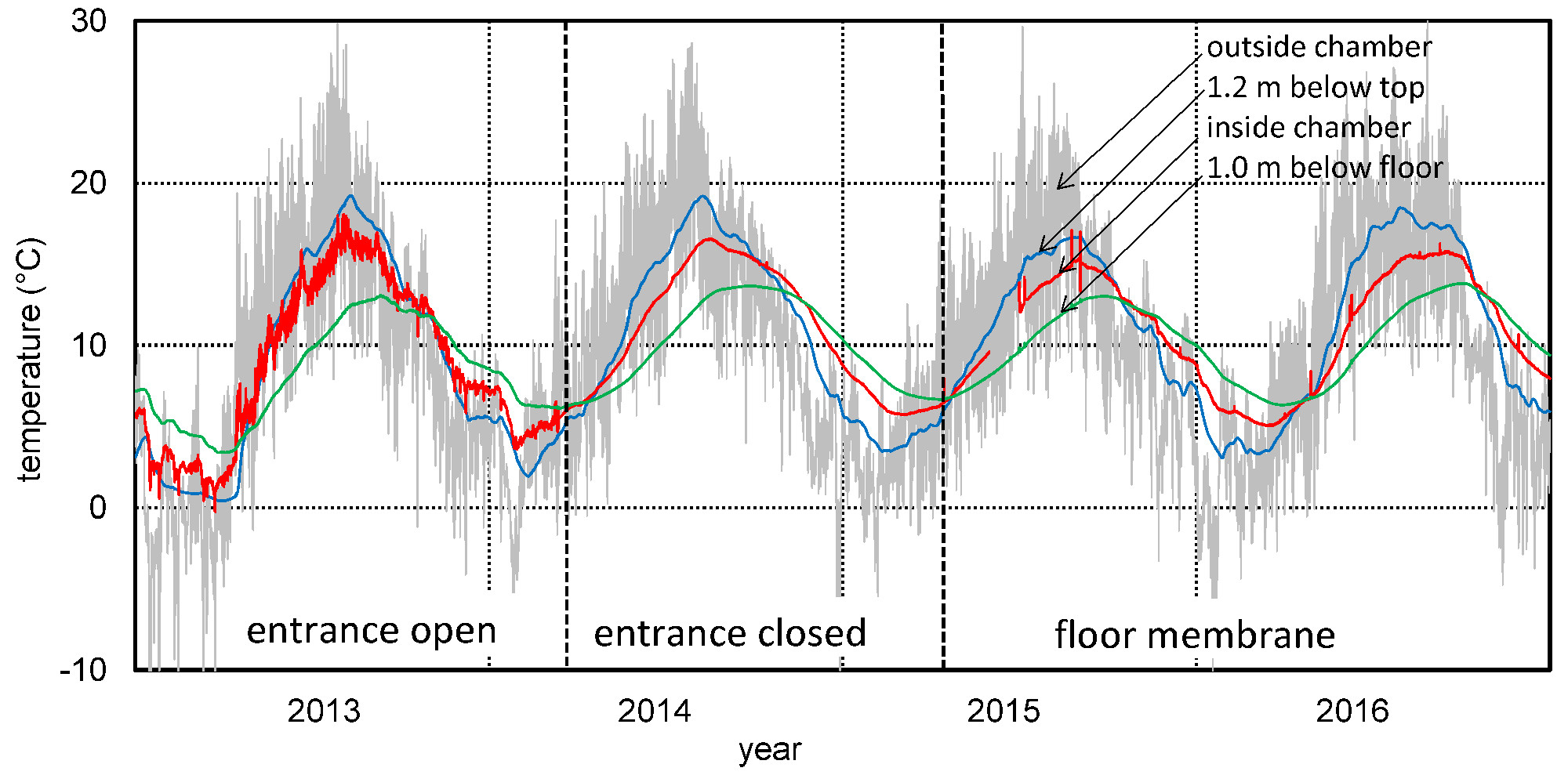
The temperature of the air inside and outside the chamber, in the soil above and below the chamber, over a four years period.
The inside temperature followed the outside annual temperature cycle with a reduced amplitude between 6°C and 16°C and a phase delay of one month. The vertical temperature gradient through the chamber is indicated by the temperature in the mound above and the ground below. In summer, the ground was colder than the mound, and in winter it was the opposite. The thermal inertia and the seasonally changing heat flow controlled the temperature in the chamber during the year. Natural ventilation though the open door only influenced the daily variation. The record of relative humidity within the chamber and soil wetness in the ground below the chamber is shown in the figure below.
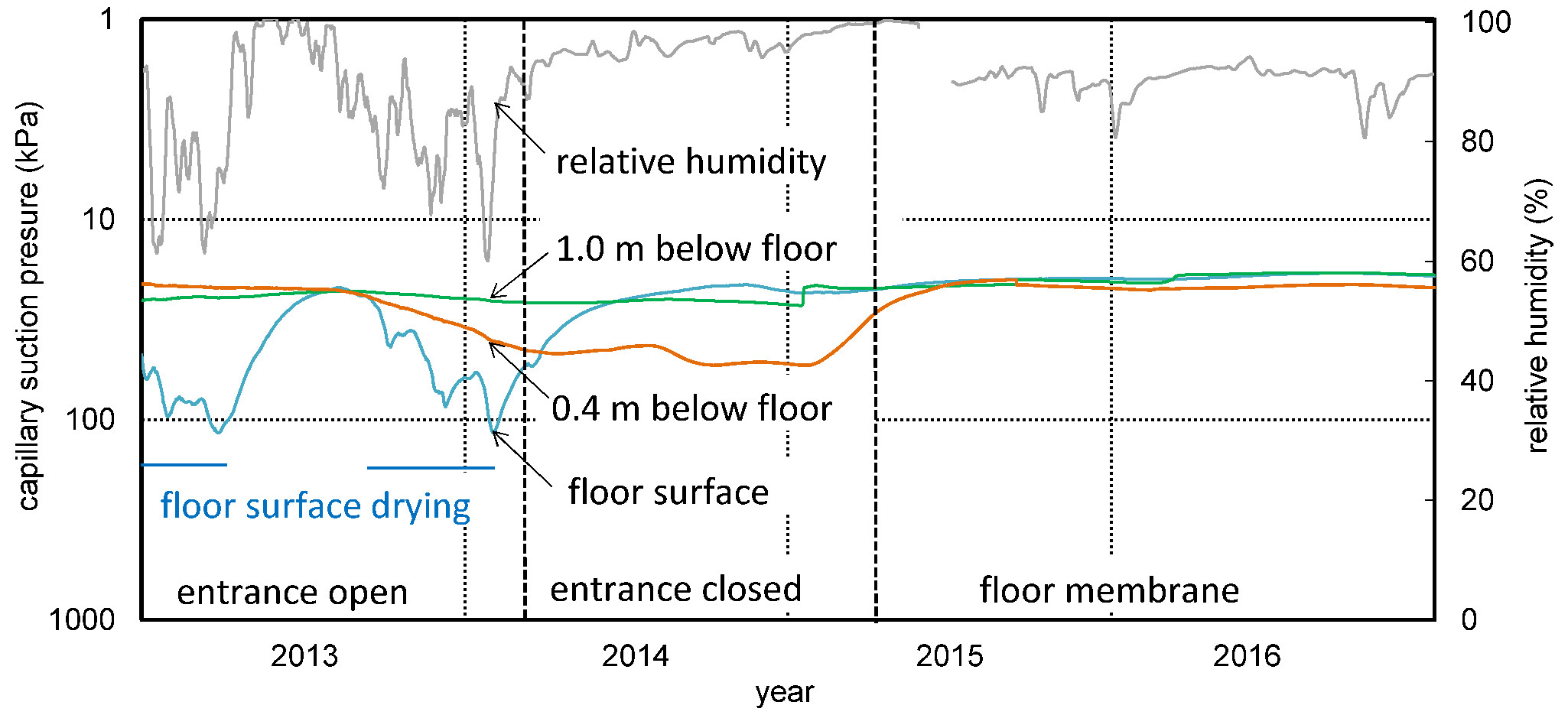
Relative humidity inside the chamber, and suction pressure of the soil below the floor, over a four year period.
In the first year, there were episodes of 100% RH during the spring and early summer, when the chamber was colder than the dew point of the warm humid air outside. In contrast, during the winter, the RH of the incoming cold air was reduced in the warm chamber, down to 50% during very cold weather. In the second year after the door was sealed, the RH was much more stable, but always above 90%. In 2015, the RH gradually came close to 100%, and the RH sensor stopped working in May 2015. When a new sensor was installed after a month, it showed a reduction in the RH to around 90%. This event occurred two months after the installation of the floor membrane. For the remaining period of 2015 and 2016, the RH stayed around 90%, with occasional drops to 80%.
The suction pressure in the top soil of the floor responded to the RH in the chamber. When the RH decreased during the first year, there was a rise in capillary pressure. This indicated that the topsoil dried out, whereas there was no indication of drying deeper in the ground. When the RH was above 90%, the topsoil remained at the same low suction pressure during all seasons.
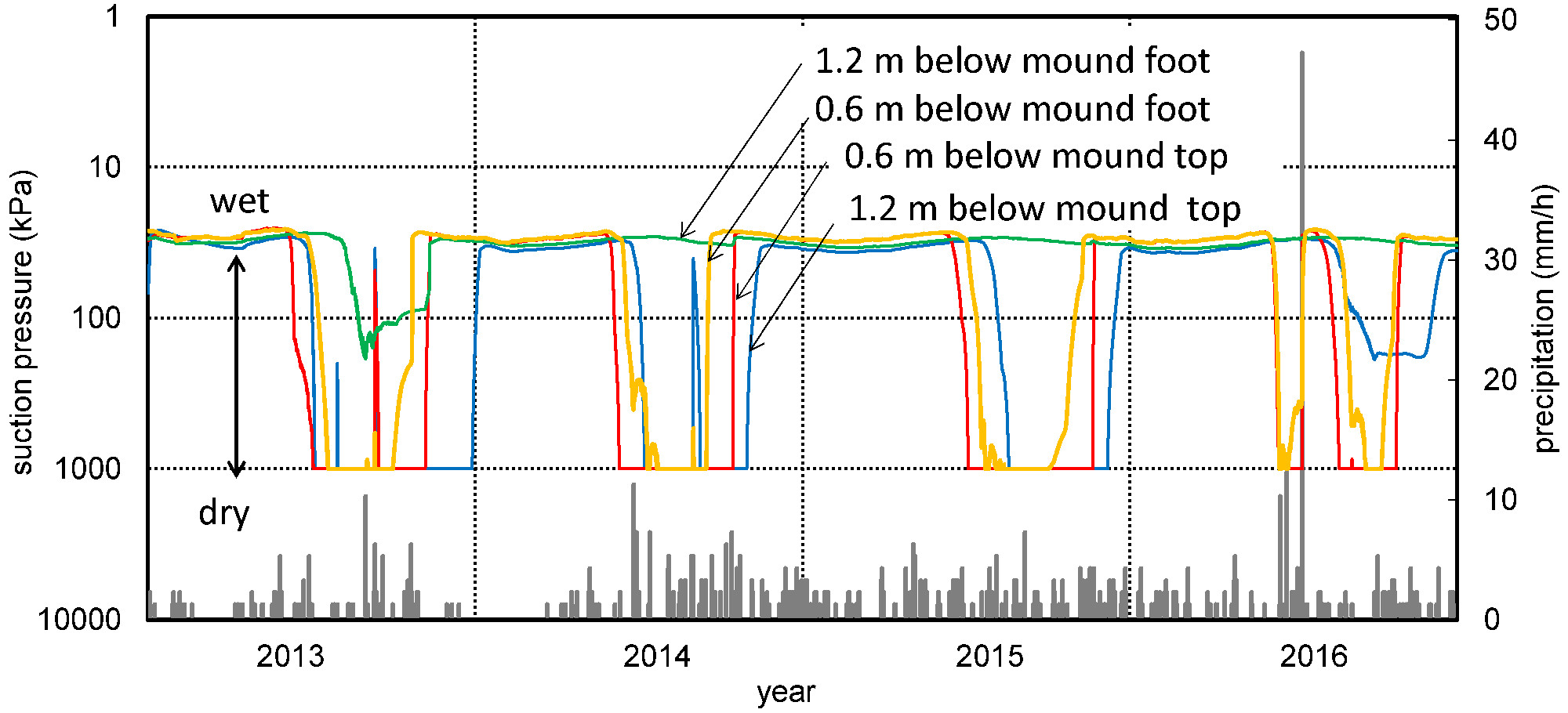
Suction pressure of the soil in the mound above the chamber and at the foot of the mound, and precipitation (grey columns) over a four years period.
There was a seasonal variation in suction pressure each year. The soil dried out during the spring and summer, and became wet again during the autumn. The soil 1.2 m deep at the foot of the mound only dried the first summer, and remained wet in the following years. The precipitation was rather constant during the year, so the seasonal change in wetness was mainly attributed to evaporation in the summer. An episode of intense rainfall in July 2016 increased the soil wetness, so the dry period was significantly reduced that summer.
The natural air exchange rate (AER) was measured in two 3-week periods in February and August 2016 with the entrance sealed. The per-fluorocarbon tracer-gas (PFT) method was used, in collaboration with The Danish Building Research Institute (Bergsøe, 1993). An inert fluorocarbon tracer gas was released at a constant rate from a metal tube located in the centre of the chamber. The gas was collected into eight glass tube samplers mounted at the perimeter of the chamber. The content of tracer gas in each collector tube was analyzed by gas chromatography with mass spectrometry (GCMS). The amount of gas collected was a measure of the average concentration, which depended on the infiltration of outside air. The results are given in Table 1. The sealed chamber experienced an average air exchange rate of 0.34 hour-1 in February and 0.16 hour-1 in August. In June 2016, an attempt was made to locate the air leaks in the chamber. Cold smoke was released and a fan was installed in the door to provide a slight overpressure in the chamber. A small amount of smoke escaped through the entrance above the door. But no air flow was observed through mouse holes or the mound´s porous soil.
The ozone concentration inside the closed chamber was investigated during the spring of 2016. An elastomer dosimeter (stretched rubber bands) was exposed inside the closed chamber, following the methodology of Ryhl-Svendsen, 2008. After four months, it showed no visual sign of degradation, which indicates an average concentration well below 1 ppb. This was backed up by a direct concentration measurement using diffusion tubes, carried out during April 2016. Inside the closed chamber, the ozone level was below the detection limit of the technique (<0.7 ppb). For the same period, the average ozone concentration was 22 ppb just outside the entrance. Following this, the ingress of ozone was measured for the chamber while the entrance was kept open, as it had been for the previous 200 years. During two sunny days in June 2016, the ozone level was measured inside and outside the chamber for a continuous period of 48 hours, using UV-based real-time ozone monitors. The ozone level in the middle of the open chamber was 8 ppb (average), however it varied much between day and night (<1 to 15 ppb). The indoor-to-outdoor concentration ratio, however, remained largely constant at 0.25. Short-term spot measurements just in front of the chamber walls, near the birch bark rolls, revealed slightly lower indoor/outdoor ratios of about 0.20.
In the first year, the inside dew point was almost the same as outside, due to the natural ventilation through the open entrance. There were large daily and seasonal variations controlled by the ambient conditions. When the chamber was sealed in the second year, the inside dew point became much more stable. In the first months, the inside followed the outside average, but later in the year, the inside dew point was much higher than outside. There was an internal source of humidity, which was powerful enough to compensate for the loss by the now reduced ventilation. After the floor membrane was installed, the dew point inside followed the outside average with some delay.
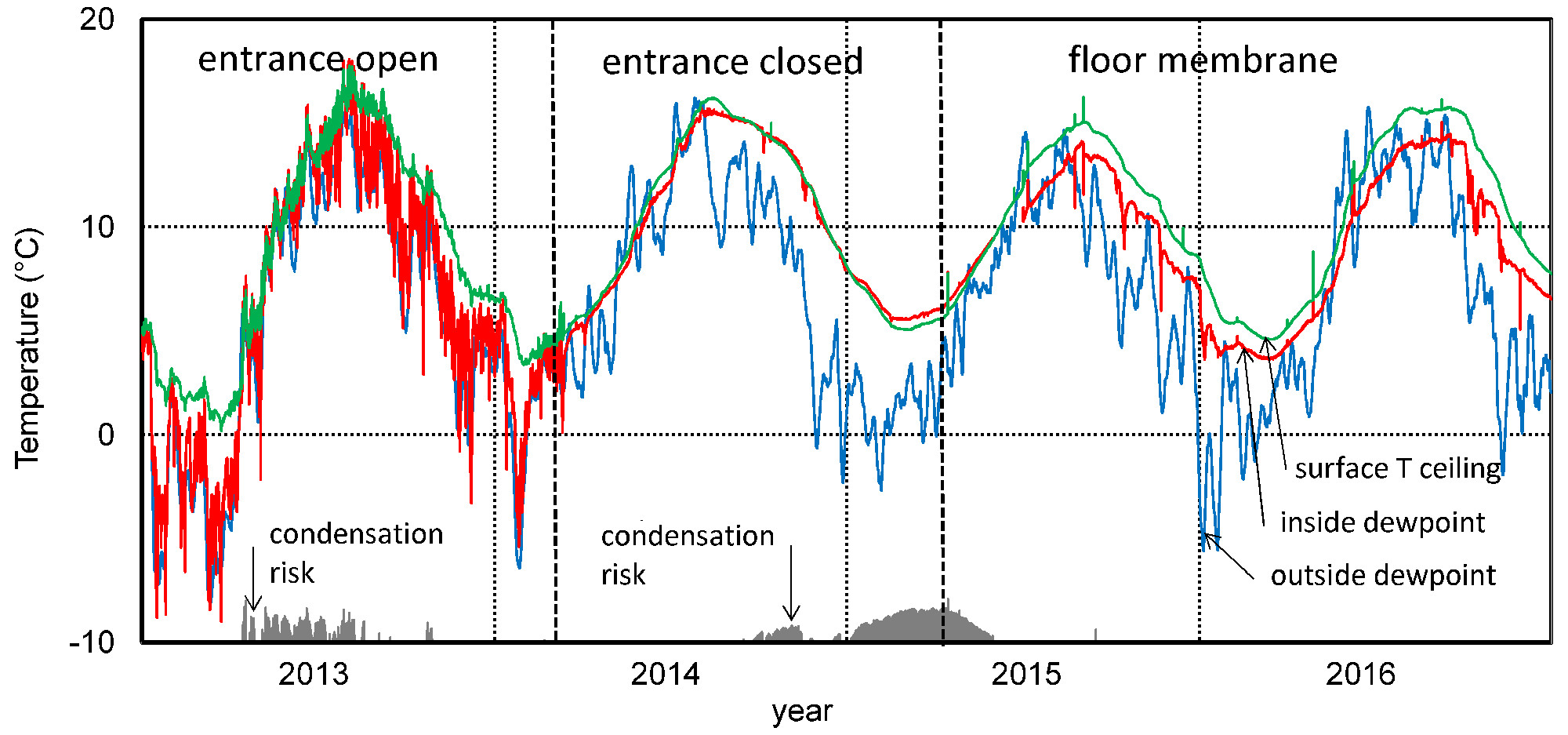
Dew point temperature of the inside and outside air and surface temperature of the ceiling, over a four years period. The outside dew point is shown as a seven days moving average. The risk of condensation on the ceiling is indicated with grey bars below in the diagram.
An expanded graph for the first year (click to enlarge), showing condensation when the interior dewpoint exceeds the ceiling surface temperature. The interior dewpoint follows the outside dewpoint because of the high air exchange rate. The condensation risk is displayed as ten times the temperature excess of the interior air dewpoint over the ceiling surface temperature. In the autumn, the ceiling temperature is much more stable, because of the gravitational stability of warm air at the top.
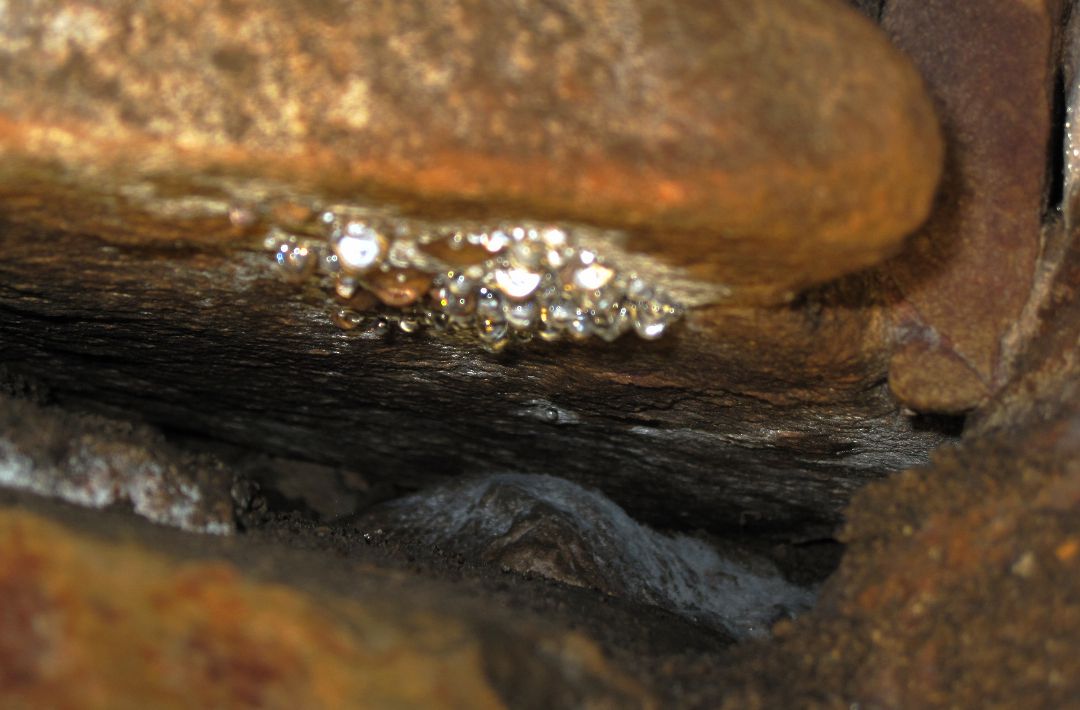
Condensation on the ceiling, on 2 July 2013.
The risk of condensation is indicated at the bottom of the graph above. The grey bars show the difference between the surface temperature of the ceiling and the dew point of the air in the chamber. When the dew point was higher than the ceiling surface temperature, there would be liquid water forming on the stone. With free ventilation, there was condensation mainly in summer, when the warm outside air entered the colder chamber. Without ventilation, there was condensation in winter, because humidity would evaporate from the warmer floor to the colder ceiling. As the water drops became too heavy, they fell to the floor and were absorbed by the porous surface. This repetitive cycle took place over several millennia after the chamber went out of use. The natural conditions inside the chamber have been very humid for a very long time, and yet the birch bark survived.
As long as the door was open, the floor topsoil would dry out during the winter, but without this annual drying season, the soil at the floor surface was wet all the year. The soil deeper below the floor was always wet, supplied by precipitation on the open ground around the mound. The installation of a floor membrane prevented the evaporation and kept the chamber condensation free at all seasons. This proved that the main contribution of humidity came from the floor, and not from the soil in the mound above the chamber. The soil above the chamber served the purpose of absorbing the rainfall, so it would not penetrate into the chamber. The soil also protected the clay layer above the ceiling stones against mechanical damage.
The natural air exchange rate of the closed chamber was twice as high in winter as in summer. The opposite was expected because the wet soil in winter would be less permeable for air than the dry soil in summer. The AER was also quite high compared to ordinary buildings with windows and doors. The ozone measurements indicated a very low infiltration of outside air. On the other hand, this very reactive component of the air may simply have been removed by reaction with the soil on the way through the mound, acting like an air filter. Regardless of how much air gets in and out of the chamber, the ozone level will be very low when the chamber is sealed. This must have been the situation for most of the chamber’s lifetime. But when the door was opened 200 years ago, ozone could freely enter the chamber. A qualified estimated of the accumulated ozone exposure, based on the established indoor/outdoor concentration ratio, and taking current and historic annual ozone trends for Denmark into account, is that the birch bark has been exposed to somewhere between 800 to 1000 ppb-years of ozone. The concentration of oxygen was not measured during this campaign, but from the rapid air exchange rate it seems unlikely that the chamber was ever anaerobic.
The general assumption that ventilation is always good for preservation does not apply to a passage grave. The benefit of natural ventilation depends on the hygrothermal characteristics of the construction being considered. A passage grave has a high thermal inertia, so the daily temperature fluctuations are diminished and the annual temperature amplitude is reduced and delayed. An open chamber has a rapid infiltration of outside air, and will experience a more variable RH than ambient. The RH goes down to 50 %RH in winter and reaches 100% with observed condensation in spring and early summer. Drying makes the bark brittle and thus more susceptible to mechanical damage.
A closed chamber is not air tight, but the influence of outside air is less dominant. The RH in the closed chamber is high and stable all year due to evaporation of moisture from the floor. Penetration of rain from above is not a significant source of humidity to the chamber. The structure of this, and other mounds of similar age, shows that care was taken for drainage of surface water away from the grave chamber. The birch bark between the sandstone slabs was preserved in this humid environment for over 5000 years. Birch bark is resistant to degradation by fungi and bacteria, and it does survive in humid conditions. The high RH inside the closed chamber was better for the preservation of the bark.
An important aspect of natural ventilation is the air quality, in particular the concentration of ozone. When the chamber is closed, the inside concentration of ozone is almost zero. This is partly because of the moderate air exchange rate, partly because the incoming air is filtered through the soil. With an open chamber, the inside concentration of ozone is 25 % of that outside. The reopening of the chamber 200 years ago enabled ozone to penetrate the chamber for the first time since the Neolithic period. The role of ozone as a slow agent of deterioration of bark is not certain, but keeping the chamber sealed removes this threat entirely. Another cause of damage was surely the opening of the chamber to visitors of all species. Perhaps some of the reported damage relates to humans touching the fragile bark layers. The role of wildlife in removing the bark has not been studied, but putting a gate in the entrance will hardly hinder small animals from exploring the chamber. The bark will be best protected by keeping the chamber sealed.
There are many other passage graves in Denmark accessible to the public, but none with such an amount of organic substance preserved. Visitors can enjoy the impressive structure of a grave chamber with large, heavy stones elsewhere. It is an essential obligation to protect this unique example of Neolithic craftsmanship. An acceptable compromise would be to keep the chamber closed, but arrange guided tours for groups of visitors.
We thank The Agency for Palaces and Culture for funding the monitoring campaign. Archaeologists Jørgen Westphal and Torben Dehn provided information about the history of archaeological studies and supported the work.
Bergsøe, N.C. 1992. Passive tracer gas method for ventilation investigations. Description and analysis of the PFT-method. SBI report 227. Hørsholm: Danish Building Research Institute.
Dehn, T., Hansen, S.I., Westphal, J., 1998. Jættestuen Birkehøj. Nationalmuseets Arbejdsmark, pp. 153-173 (in Danish with English summary and captions)
Dehn, T., Hansen S. I., 2006. Birch bark in Danish passage graves. Journal of Danish Archaeology vol 14, pp. 23-44
Orsini, S., Ribechini, E., Modugno, F., Klügl, J., Di Pietro, G., Colombini, M.P., 2015. Micromorphological and chemical elucidation of the degradation mechanisms of birch bark archaeological artefacts. Heritage Science, vol 3(2), 11 pp.
Ryhl-Svendsen, M., 2008. Ozone detection using natural rubber dosimeters: Quantitative measurements using light microscopy and attenuated total reflectance spectroscopy. Zeitschrift für Kunsttechnologie und Konservierung 21(2), pp. 240-249.
Suryawanshi, D.G. 2004. Birch bark and its mechanical properties. Restorator. International Journal for the preservation of library and archival material, vol 25, no. 2, pp 75-80.
A summary of this report will be published in the ICOM-CC preprints, Copenhagen 2017.
Power supply: two 65AH lead-acid batteries, good for 3 months operation.
Datalogger: Campbell Scientific CR1000WP with AM16/32B 16/32 multiplexer mounted in ENC 16/18 box.
Combined temperature and RH inside and out: HC2S3 Rotronic Hygroclip2 mounted in radiation shield MET21.
Stone surface wetness: Campbell Scientific 237F Wetness sensing grid resistors. These proved unreliable after a few months of operation in this high RH environment.
Rain gauge: Texas Electronics TR-525M. This is a tipping bucket device.
Soil moisture: Delmhorst gypsum block.
Surface temperature measurements: Thermocouple type K. Type K is suitable for this study because both wires are corrosion resistant, strong and springy, with a low thermal conductivity, so there is minimal heat transmission from the chamber air towards the fine tip which is sprung against the stone surface with about 10 mm nearly parallel to the surface.
Data transmission from the datalogger was by mobile phone network, using a Wavecom Fastrack Supreme 10 (already obsolete)
Diffusion samplers (tubes) for ozone: Gradko International Ltd., Winchester, U.K.
Ozone meters: Model 205 Dual Beam Ozone Monitor, 2B Technologies, Boulder, Colorado, USA. This measures UV Absorption at 254 nm compared to a clean reference air path.
Ozone dosimeters: Ordinary “post office” rubber bands, 10 mm wide, and stretched to double length on an aluminium rack. Exposures were conducted in triplicates. Visual analysis was conducted in reflected light using a stereo microscope at 40x magnification.

All the sensors installed at Maglehøj. The numbers refer to the columns in the data file.

This work is licensed under a Creative Commons Attribution-Noncommercial-No Derivative Works 3.0 License.